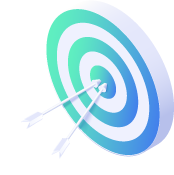Make Your Data Work For You
Data Visualization
Bring Your Data to Life
Data visualization is all about representing the data, but to represent the data you need to understand the context and the story. It can be easy to get hung up on picking the right visual tool. Should I use PowerBI or Tableau? SQL, Python, or R? While some programming languages or business intelligence tools may be better suited to specific data sets or goals, data visualization can be done using a variety of software tools and languages.
If you have a blank slate, the choice of software depends on the complexity of the data, the size of the dataset, the level of interactivity required, and the specific needs of the organization – but any of these tools can be used to develop dynamic, accessible, and functional data visualizations to improve your understanding and workflows. At KJ, our team works with a variety of tools to develop dashboards that serve our clients and our internal staff. The key is not the tool you choose but the result.
If you currently have a tool in place, even if that tool is Excel, our team can find ways to make your data more visually accessible for better insights. The core of data visualization is creating representations of data that users can understand and analyze more quickly and effectively than standard spreadsheets or reports. The visualization must serve the decision-making team.
Six Steps to Develop Visualizations That Serve Your Team
Understand your user needs: Consider the primary audience for your data and how the dashboard visualization will be used.
Establish the right performance indicators: Think about what your users need to know and what decisions they need to make. Choose the right performance indicators to tell the right story.
Know how to slice your data: Databases can contain vast quantities of data attributes, not all of which will be will relevant to your team.
Roll-up to organizational goals: Dashboards can only improve decision-making if they roll-up to management goals. Without clear line of sight to organizational purpose, the dashboard is just pretty.
Perform user testing: The best dashboard is the one your staff will use! User testing confirms that the dashboard delivers to the people who will use it.
Plan your dashboard maintenance: For the most part, a dashboard is “set and forget it” – once the data sources are linked and the visualizations established, all you must do is view your insights. But the world is always changing, and so may your needs.
Data visualization is a key tool that helps to make data more accessible and understandable by using visual elements that are easy to interpret, allowing users to quickly identify patterns and trends, and make data-driven decisions.
Understanding User Needs
To get the most out of your data through visualization, you need to start with a clear understanding of what information your users need. Visualization can only help users understand and analyze data more effectively if it is responsive to user needs. End users should be involved in dashboard development to identify what data, patterns, and trends will give them what they need to make better decisions. KJ begins dashboard development with a deep dive into your data and your user needs.
The Audience
It all starts with identifying the primary audience for the visualization. The role of the user, their technical expertise, and the story they need the data to tell must be clear before the dashboard is constructed. Secondary user goals can be incorporated once the primary audience is established. A visualization serving field staff may look different than one intended primarily for management. Once the primary audience is selected, it is important to find out how they currently work with their data.
The Problem
Massive amounts of data may be available, but not all this data will be relevant to the problem at hand. We start by investigating what users currently do and what frustrates them in the workflow. Data visualization offers a shortcut to data analysis by creating relationships between data that can be updated and analyzed in the same way over time. Understanding the key problem that data visualization is intended to solve helps in selecting the right data to include and finding alternate workflows to streamline and potentially transform the process.
Visuals
People often assume that the purpose of data visualization is to “make data beautiful.” Really, the main goal of data visualization is to make data accessible and functional. The purpose of visualization is communication, not beauty. Different visualizations will be dictated by the data under analysis and by the needs of the end users. Visually attractive dashboards are only effective if your team can easily interact with the data for a better understanding of data relationships.
Accessibility
Visuals need to be easy to understand. The purpose of data visualization is to improve data knowledge. A new user should be able to quickly understand what the visualization is communicating and how to change inputs to track different performance indicators or goals over time. If there are any additional accessibility needs – e.g., color blindness can affect the readability of charts and graphs – these should be addressed.
Access
Users may need varying levels of access to dashboards. Understanding who needs the information and why they need it helps to establish access rules and prevent accidentally tinkering with dashboard components. If different user groups share the same dashboard, how will that affect the visualization, and what tools will be needed to engage each group? Will teams be using the dashboard in the field or at a desk?
Real-World Testing
Data visualizations are only successful once they are tested by end users. Developers should work directly with end users to confirm visualizations tell the right story. A data visualization that misses key data can give users the wrong information, and a visually striking dashboard that no one uses will serve no purpose. User testing does not need to wait until the dashboard is complete. Working with users during different phases of dashboard design can dramatically decrease the amount of time spent reworking the design.
Key Performance Indicators for More Valuable Insights
Data visualizations can increase the number of available performance metrics by bringing data together, but overcrowded dashboards may overwhelm users and hide critical information in a sea of charts and graphs. Good dashboard design requires understanding the key performance indicators (KPIs) that will drive decision-making. At KJ, we do not use cookie-cutter, one-size-fits-all dashboard design. We tailor the dashboard to the organization and its business goals.
KPIs are measures of performance that are tracked to reveal insights about your business and how well you are meeting business objectives. KPIs will track measures related to strategic goals across your organization. They act as a scorecard of your business health.
The basic rule (often attributed to management guru Peter Drucker) is “if you can’t measure it, you can’t improve it.” Measuring the right things can provide deeper insight into what works and what needs improvement.
Key Performance Indicators (KPIs)
A set of quantifiable measurements used to gauge a company's overall long-term performance.
At the same time, measuring the right things is a tricky proposition. Often, we end up measuring and trying to improve things that correlate with, rather than cause, the end goal. The wrong performance measures can lead to wasted time and effort, and worse, public relations problems. If the wrong KPIs, or too few KPIs, are selected, there are risks that the measure will become the target.
Goodhart’s Law: When a measure becomes a target, it ceases to be a good measure.
Selecting the right mix of KPIs and understanding the story you need to tell your team, your stakeholders, your staff, or your board is a critical part of the dashboard development process. Poorly selected KPIs will give you a skewed representation of your performance that can lead you in the wrong direction.
We start dashboard development with understanding of your user needs and structure KPIs in a data model that aligns with those needs to illuminate progress towards corporate or project goals. KJ recommends regular review of KPIs to keep them aligned with your business objectives. No KPI will tell the whole story, but as your goals and the business environment change, you should update and reflect on your KPIs.
Slice Your Data for More Effective Analysis
Slicing Data
Once you select your performance or process indicators and establish your data sources, you can begin building visualizations to creatively slice data for more effective analysis. Slicing means focusing on subsets of your data for manageable or more rigorous analysis. Reducing the number of fields or data attributes can improve data analysis by removing extraneous information.
Using a dynamic dashboard, you can interact with data in a variety of ways:
Filter: Using data visualization tools, you can filter data based on criteria like date range, location, or category to focus on specific segments of the data and understand patterns and trends within those segments.
Grouping: Using data visualization tools, you can group data based on specific criteria, such as time periods, geographic regions, or product categories. This can help users to identify patterns and trends across different segments of the data and understand how key factors are impacting performance.
Pivoting: Pivoting means reorienting data, and rotating it in a way that allows for different perspectives. Users can explore data from different angles to understand how factors interact.
Drill-down: Data visualization tools allow users to drill down into specific data points to see more detailed information. Users can better understand the underlying causes of patterns and trends to identify specific areas of concern.
Combinations of these different slices of data can present multiple aspects of data in a single view, allowing users to identify patterns and trends that might not be obvious from a single visualization.
Building the dashboard can involve a little serendipity – sometimes the act of pulling data into the data visualization uncovers relationships that users did not expect. These happy accidents can provide new ways of working with data and new ways of solving problems.
Working with thinner slices of data can also provide clearer insight into potential interventions for program or process improvements. Small data slices can be quicker and easier to review and generate potential solutions that can be quickly pilot tested. Dashboards let multiple users work with the same data at different levels, with users slicing the data as needed to achieve the right content and level of detail. Because the data may be pulled from multiple sources, working with the data through the dashboard helps maintain data integrity and reduce data entry errors.
Dashboards that Work for Your Team
When designing dashboards, it is common to start with what it is possible to show based on the data. There are exciting opportunities to juxtapose data in new ways. But dashboards are intended to be communication tools that work for your end users. User testing can reveal flaws in initial dashboard design. Addressing user feedback leads to better engagement and dashboard use.
User testing takes place multiple times during dashboard development, as data managers assess which information and visualizations show your identified KPIs in fruitful ways. We work with end users to verify and test the usability of the tool, adapting visualizations to serve end users. When dashboards are in the final stages, users are asked to run through a series of specific tasks to find weak points or bugs in the design, then asked about the user experience and potential improvements.
This collaborative effort streamlines visuals and improves adoption of the dashboard. If there are multiple user groups, each group should have the opportunity to provide feedback on the user experience.
We look for opportunities to:
Reduce the density of information
Streamline graphics for ease of understanding
Identify and correct bugs or bad links
Identify missing information or context
Identify and correct errors
Improve navigation and reduce number of clicks
Overall, user testing gives a sense of how people will instinctively use the dashboard to gather information. Exploring the dashboard with users and requesting feedback on the user experience improves the end product and increases user adoption. And when end users can participate in dashboard development, they are more likely to use the final product.
Scheduling a Tune-up for Your Dashboard
Keeping Dashboards Fresh
One key advantage of a dashboard for data analytics is that you can pretty much “set it and forget it.” Instead of manually creating new charts and tables every time you need to analyze a dataset, you can build a dashboard in your business intelligence tool that will automatically populate with real-time data as the source is updated.
But regulations, metrics, goals, and data sources can change. And the more customizations your dashboard contains, the higher the chance for something to eventually go wrong. Like any other asset, your dashboard will need some maintenance, maybe even regular tune-ups.
Setting triggers to review and update your dashboard, verify data, and confirm the utility of key insights is critical to maintaining the value of your dashboard. Any time that regulations change, it should trigger a review of your dashboard and related data sources to confirm that performance indicators have not been affected. Even when regulations change, metrics can change as you gain insight into the relationship between your dashboard and your business questions. Goals can change as the business environment shifts. And data sources can change as software is replaced or upgraded, or new digital tools offer new opportunities to collect and visualize data.
Monitoring dashboard use can also tell you how effective your dashboard is. If a team is not actively using its dashboard to improve workflows and decisions, then it is time to update the tool. Ask your team what they need to see and find ways to show that data. No matter how well-designed a dashboard seems, if your team is not using it, it cannot be effective. Improving engagement with your dashboard might be as simple as changing visuals, or it might mean rethinking the purpose of the dashboard. In either case, maintenance is needed to keep engagement high.
Make it easy for your team to report on issues to keep them using their dashboard. If you have multiple dashboards across several teams, setting up an automated error reporting tool can help keep everything on track. If your team notices a broken link or data that is not properly updating, a simple form to report the issue can streamline maintenance to keep the dashboard current.














